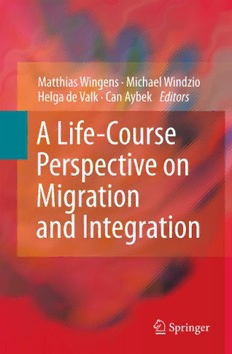Table Of ContentA Life-Course Perspective on Migration
and Integration
Matthias Wingens Michael Windzio
(cid:2)
Helga de Valk Can Aybek
(cid:2)
Editors
A Life-Course Perspective
on Migration and Integration
123
Editors
MatthiasWingens MichaelWindzio
BremenInternationalGraduate UniversityofBremen
SchoolofSocialSciences(BIGSSS) EMPAS
UniversityofBremen 28334Bremen
28334Bremen Germany
Germany [email protected]
[email protected]
CanAybek
HelgadeValk UniversityofSiegen
NetherlandsInterdisciplinaryDemographic DepartmentofPoliticalScience
InstitutetheHague 57068Siegen
and Germany
InterfaceDemography [email protected]
VrijeUniversiteitBrussel
POBox11650
2502ARTheHague
TheNetherlands
[email protected]
ISBN978-94-007-1544-8 e-ISBN978-94-007-1545-5
DOI10.1007/978-94-007-1545-5
SpringerDordrechtHeidelbergLondonNewYork
LibraryofCongressControlNumber:2011931669
© SpringerScience+BusinessMediaB.V.2011
Nopartofthisworkmaybereproduced,storedinaretrievalsystem,ortransmittedinanyformorby
anymeans,electronic,mechanical,photocopying,microfilming,recordingorotherwise,withoutwritten
permissionfromthePublisher,withtheexceptionofanymaterialsuppliedspecificallyforthepurpose
ofbeingenteredandexecutedonacomputersystem,forexclusiveusebythepurchaserofthework.
Printedonacid-freepaper
SpringerispartofSpringerScience+BusinessMedia(www.springer.com)
Contents
1 TheSociologicalLifeCourseApproachandResearchon
MigrationandIntegration................................................. 1
MatthiasWingens,HelgadeValk,MichaelWindzio,
andCanAybek
2 Immigrants’EducationalAttainment:ACloserLookat
theAge-at-MigrationEffect............................................... 27
JaninaSo¨hn
3 VaryingHurdlesforLow-SkilledYouthontheWaytothe
LabourMarket ............................................................. 55
CanAybek
4 Individual Resources and StructuralConstraints in
Immigrants’LabourMarketIntegration................................ 75
IrenaKogan, FrankKalter, ElisabethLiebau,
andYinonCohen
5 OvercomingBarriers. CareerTrajectoriesof Highly
SkilledMembersoftheGermanSecondGeneration................... 101
KarinSchittenhelm
6 IntegrationTrajectories:AMixedMethodApproach ................. 121
RossalinaLatchevaandBarbaraHerzog-Punzenberger
7 NationalContextandLogicofSocialDistancing:Children
ofImmigrantsinFranceandGermany.................................. 143
IngridTucci
8 Paths to Adulthood: A Focus on the Children
ofImmigrantsintheNetherlands ........................................ 165
HelgadeValk
v
vi Contents
9 LinkedLife-Events.LeavingParentalHomeinTurkish
ImmigrantandNativeFamiliesinGermany............................ 187
MichaelWindzio
10 OccupationalMobilityintheLifeCourseofIntermarried
EthnicMinorities........................................................... 211
RayaMuttarak
11 TheEffectofEthnicSegregationontheProcessofAssimilation ..... 239
AndreasFarwick
12 ImmigrantIntegration,TransnationalActivitiesandthe
LifeCourse.................................................................. 259
ReinhardSchunck
13 ImmigrantSettlementandtheLifeCourse:AnExchange
ofResearchPerspectivesandOutlookfortheFuture.................. 283
HelgadeValk,MichaelWindzio,MatthiasWingens,
andCanAybek
Chapter 1
The Sociological Life Course Approach
and Research on Migration and Integration
MatthiasWingens,HelgadeValk,MichaelWindzio,andCanAybek
Overthelastfourdecadesthelifecourseperspectivehasbecomeanimportantand
fruitful approach in the social sciences. Some of its proponents even claim that
the life course approach today is the pre-eminent theoretical orientation and new
core research paradigm in social science (Elder et al. 2003; Heinz et al. 2009).
Although not everyone will agree with this far reaching claim, few will dispute
that the life course approachconstitutes a promising conceptualstarting point for
overcoming the crucial micro-macro problem in social research by analysing the
dynamicinterrelationofstructureandagency.Thelifecourseperspectivehasbeen
successfullyappliedtoempiricalresearchinawiderangeofsociologicalaswellas
demographicstudies.Inlinewiththedevelopmentofthelifecourseapproachalso
migrationandintegrationissues havebecomecoretopicsof debatein society and
aresubjectofagrowingnumberofstudiesoverthepastyears.Despitethissimilar
development in time, exchanges between the life course approach and migration
research are still rather limited. Reviewing the booming migration literature in
Europe it is striking that the large majority of studies do not or only partially
M.Wingens((cid:2))
BremenInternationalGraduateSchoolofSocialSciences(BIGSSS),UniversityofBremen,
28334Bremen,Germany
e-mail:[email protected]
H. deValk
NetherlandsInterdisciplinaryDemographicInstitutetheHagueandInterfaceDemography,
VrijeUniversiteitBrussel,POBox11650,2502ARTheHague,TheNetherlands
e-mail:[email protected]
M.Windzio
InstituteforEmpiricalandAppliedSociology(EMPAS),UniversityofBremen,
28334Bremen,Germany
e-mail:[email protected]
C.Aybek
DepartmentofPoliticalScience,UniversityofSiegen,57068Siegen,Germany
e-mail:[email protected]
M.Wingensetal.(eds.),ALife-CoursePerspectiveonMigrationandIntegration, 1
DOI10.1007/978-94-007-1545-5 1,©SpringerScienceCBusinessMediaB.V.2011
2 M.Wingensetal.
use the sociological life course approach. Even though a study already carried
out in the early twentieth century became a classical study in migration research
as well as in the life course literature. In the “The Polish Peasant in Europe and
America” (1918–1920), the authors Thomas and Znaniecki basically apply a life
courseapproachto thestudyofPolish migrantscomingtothe US. Theyaimedto
explain social changes and changes in, for example family relations, by focusing
on the interaction between individual migrants and the host society. This line of
research has however not been fully taken further in research since then. Even
though migration has become one of the major factors in population change in
Europe today (Coleman 2008; Taran 2009) and the resulting significant amount
of research in social sciences, the main focus of recent studies has been on the
position of migrants in education and the labour market as well as on issues of
identity and belonging (Heath et al. 2008; Van Tubergen 2005; Verkuyten 2001).
Studies mainly aim to explain the specific position of migrants after migration.
In demography,studies have looked at specific transitions like timing of the first
childorintermarriagewithnativepartners(Coleman1994;Gonza´lez-Ferrer2006;
Kalmijn and van Tubergen 2006; Milewski 2008). In the study of international
migration moves different, often economic explanations of migration decisions
are taken. Only recently more emphasis has been put on the linked lives and the
roleof family andothernetworksforfacilitating the migrationmove(Castles and
Miller 2009). That the life course approach is only limitedly used in migration
studiesis atleastpuzzling:Understandingmigrants’behaviourandexplainingthe
cumulative effects resulting from their actions which, in turn, are embedded in
societal structures and framed by institutions, requires just the kind of dynamic
research approach the sociological life course perspective suggests. This is even
moresothecaseforstudiesonintegrationissues,asintegrationprocessesactually
directlyrefertolifecourseprocesses,beitinter-generational(cohortdifferences)or
intra-generational(individualcareers).Atthesametimemoststudiesinthisdomain
focusonthepositionofmigrantsinsocietybystudyingtheprocessofsettlementin
thehostsocietyonly.
The purpose of this book is to link the sociological life course approach and
migrationresearchmoreexplicitlyandprovideclearsuggestionsonhowtotakethis
further.A compilationofempiricalstudiesin thisbookshowshowthelife course
approachcanbetakenupinthestudyofmigrationandmigrantpopulations.Ineach
of these empirical studies the authors focus on one particular aspect of migration
or integrationand its link with the study of the life course. In this way we aim to
furtherelaborateonpotentialconnectionsbetweenbothresearchtraditions.Inorder
to make fruitfuluse and combine both strands of research one needs of course to
beawareofthestartingpointsandbackgroundofbothtraditions.Thisintroduction
givesanoverviewofthelifecourseapproachandpresentsitstheoreticalfoundations
and basic concepts. A further exploration of links between migration/integration
research and the sociology of the life course will be provided in the conclusion.
Asociologicallifecourseapproachtomigrationfocusesonthedynamicinterplay
of societal structuring and institutional framing of migrants’ life courses and the
1 TheSociologicalLifeCourseApproachandResearchonMigrationandIntegration 3
patternsofmigrants’biographicalmasteringoftransitionsandcoordinatingoflife
spheres.Weholdthatthisperspectiveprovidesaconceptualframeworkandbearsan
analyticalpotentialwhichsofarhasnotbeenfullyexploitedbymigrationresearch.
1.1 DelimitingtheSociological LifeCourseApproach
Before describing the sociological life course approach and its link to migration
the above statement must be clarified in two respects. First, one might object
that we overstate our case because there are quite a few studies, especially when
it comes to integration of migrants, which adopt a longitudinal micro-analytical
perspective and, thus, fit well into a life course approach (Constant and Massey
2003;Chiswicketal.2005;GundelandPeters2008).Firstofallthistypeofstudies
arelimitedin Europeandonlyrecentlymoreofthistypeofstudiesareconducted
in different European countries (Constant and Massey 2003; Van Tubergen 2006;
Martinovicet al. 2009;Scott 1999;Zorlu and Mulder 2010).Second, most of the
longitudinalanalysesofimmigrantexperienceshavefocusedonthelabourmarket
andearningsofimmigrantsratherthanonotheraspectsofthelifecourse(Bengtsson
et al. 2005; Seifert 1997; Euwals et al. 2007; Kogan and Kalter 2006). For those
studies that are out there few really take the sociological life course approach
explicitly in and often only bear cursory reference to the relevant literature. This
isacrucialdifferencebetweenstartingfromasociologicallifecourseapproachand
justadoptingalongitudinalmicro-analyticalresearchdesign.Thesociologicallife
courseapproachcannotbecharacterizedintermsofacertaintype,orquality,ofdata
andmethodologyalone.Rather,italsoandessentiallyimpliessubstantialconcepts.
We, thus, argue that the sociological life course approach must not be confused,
or identified, with a longitudinal micro-analytical perspective (Mayer 2000)1 and
maintainthatitisonlybeginningtotakerootinmigrationresearch.
Second, one might point out that in recent years population studies have
increasingly adopted a life course perspective (van Wissen and Dykstra 1999;
Kulu and Milewski 2007; Myrskyla¨ 2009). This is said to have “revolutionized
demography ::: by focusing attention away from the behaviours of aggregate
populations to the consideration of the demographic behaviour of individuals”
(HoganandGoldscheider2003:690).This“paradigmshift”(Willekens1999:26)
made that populations studies moved beyond macro-level descriptions based on
sophisticated measurement towards explanation and causal theorizing (Willekens
1990;McNicoll1992).Andsinceunderstandingthemechanismsunderlyingdemo-
graphic behaviouralpatterns requires multivariate microanalyses of (longitudinal)
1Cf.alsothenewjournal“LongitudinalandLifeCourseStudies”whichstartedlastyear(Bynner
etal.2009).

